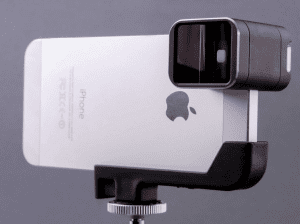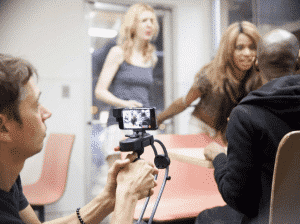“Tangerine” continues that idea as Baker narrates the story of a transgender prostitute named Sin-Dee (Kitana Kiki Rodriguez) who becomes aware that her pimp is deceiving on her and travels through Los Angeles on Christmas Eve to meet him face to face. Baker’s decision to shoot the unconventional film only using the iPhone 5S is that what has caught hold of people’s attention. Last week, Baker told Business Insider in the Manhattan office of the film’s distribution company, Magnolia Pictures that “I didn’t see any other way the film could be done.” With a extremely small budget of only around $120,000 to make the film, Baker was aware that he had made use of all his favors doing his previous films, and that if he wanted to make “Tangerine” he had to have good imagination or original ideas.
Referring to Lee’s low budget 2012 drama, Baker said “The film that turned me onto [shooting on an iPhone] was Spike Lee’s ‘Red Hook Summer. Remember the kid shooting on his iPad? There’s something about every time it cuts to his iPad footage I got more interested. I thought, Why isn’t anyone doing a whole film like this yet?” Meanwhile, Baker realized that the iPhone 5S was coming out, and it had an improved version of camera lens from its predecessors. He was sure that he could pull off shooting the movie with the phone. In total, he used three iPhones but never used it simultaneously. Baker liked the high quality of the picture the 5S provided through the camera tests he took with his co-cinematographer Radium Cheung. However, he was totally sold on shooting with the phone after coming across a new anamorphic lens adapter for smartphones created by Moondog Labs and the app, FiLMiC Pro. Baker felt the phone would be “elevated to a cinematic level”, as the lens adapter and the app made it possible for the phone to shoot at the level provided by a pricey DSLR camera. While the FiLMiC Pro app costs $7.99, the Moondog lens adapters range from $160-$175. And his financiers, who included Mark and Jay Duplass (creators of HBO’s “Togetherness”), had the same opinion after Baker showed them his test footage. Until principal photographer on “Tangerine” started in the February of 2013, Baker did not realize the level of complex shots they could pull off with the phone. As a former bike messenger, Baker utilized his talents to closely weave around his characters as they said their lines. With one hand on the handle bar of the bike and the another holding a smart-phone designed Steadicam called a “Smoothee” ($149), the movie has these sleek, eye-grabbing passing shots of Sin-Dee as she walks extremely angry throughout L.A.
However, the “crane” shots in the film are possibly the most impressive part of the cinematography. All the way through the film, a small number of scenes start high above buildings and then journeys down to the faces of the characters smoothly. Giant crane rigs used on traditional movie sets that costs thousands of dollars were used to pull this off. Baker was able to do the same shots at a low cost and in a more useful and realistic way.
“We purchased a large painter’s pole and we would rig the phone to the end of it and do these up and down movements,” Baker describes that he stands and copies the movements, which is quite close to painting the walls off the Magnolia meeting room with a long paint roller. “We would do like 10 shots, one after the other, and then look at all of them on the phone and decide if we had to do it again. It was basically like being back in your parent’s yard, 12 years old, doing stuff with the VHS camera.” Baker confesses that they would have probably used drones for some of those shots had the film been made a few years later. Baker was reluctant about promoting how “Tangerine” was shot, even though shooting with the phone was a success. Back in January, when the film entered this year’s Sundance Film Festival, he did not let any of the publicity material to reveal that it was shot with an iPhone. “We didn’t want people to have any preconceived notions about how it would look,” he said. “I have to say, if I had a choice to see a movie between a film shot on 35mm and a film shot on an iPhone, I would pick the film shot on 35mm.” However, following the premiere screening, Baker was aware that he had to disclose how they shot it. He became the poster child of the future of low budget filmmaking overnight. “It’s starting to get crazy,” Baker admits. “I’m getting way too many Facebook messages and Twitter DMs from people asking how I made the movie. I just don’t have the time to answer all of them. It’s so easy – you get the phone, you get the app, you get the rig and you just do it.” Even Apple has welcomed the film. When originally Baker had sent Apple the film treatment, they got the symbolic response that the company did not want to be involved. However, he started hearing from multiple departments in the company after the Sundance premiere with some even praising what he did. Others, not so much. “A few times they had been really nice to me, but a few times they rubbed me the wrong way,” he said. “One time a department was like, “We’re coming to your apartment and we’re going to shoot the way you edit and shoot and we’re going to spend two days with you.’ I was like no, you’re not.” Well, it looks like all is well now, as Baker said that Apple had invited the film to participate in one of their Apple Store filmmaker chats recently, and they were all presented with new iPhones. Baker has no plans to make another film on an iPhone, in the hope that with the next one he would have a much larger budget to work with. However, he believes that in the years to come, audiences would be seeing more movies made on phones. “I went to Sundance thinking we would be one of many films shot on a phone,” he said. “But a lot of people are starting to use it for features and shots. And a lot have been used for commercials already. It’s about time.” “Tangerine” opens in theaters on Friday. Watch the “Tangerine” trailer below, and experience the impressive picture quality yourself.
Source: Business Insider


